
REVIEW – Lots of golfers love using GPS devices to track their shots and determine the distance to the pin. These devices show you the course layout and where hazards might ruin your day. The issue is that distances are based on general pin positions and aren’t always accurate. Lots of other golfers prefer laser rangefinders for precise distance measurements. But these devices are one-trick ponies that only give you distance from where you are to the pin. Mileseey Golf is changing the game with their new GenePro G1 Touchscreen & GPS Rangefinder that combines a GPS rangefinder with a laser rangefinder, plus a whole lot more. Let’s dig in and see how this will change the golf rangefinder landscape.
⬇︎ Jump to summary (pros/cons)
Price: $399 (on sale from $499 as of this writing)
Where to buy: Mileseey Golf; Amazon ($499)
What is it?
The Mileseey Golf GenePro G1 is, at its core, a golf laser rangefinder that uses a laser to measure distance from where you stand to the pin on the green. In addition to that basic rangefinder functionality, the G1 adds GPS functionality and a database of more than 43,000 golf courses and a touchscreen user interface. This lets a golfer see exactly where they are on the hole, the direction to the green, record shot distances, and visualize hazards like water and sand. Combining the best features of a GPS golf tool and a laser rangefinder puts everything into one, palm-sized product. It throws a few more tricks into the mix as well.
What’s included?

- GenePro G1 rangefinder/GPS
- Hard carrying case
- USB-A to USB-C charging cable
- Microfiber cleaning cloth
- Quick start manual
- User manual
- Contact card
- Quality control pass card
Tech specs
Dimensions: 105*69*38mm
Weight: 258 g
Measurement Range: 1300 yd
Accuracy: +0.5 yd
Flag-Lock Range: 600 yd
Measuring Speed: 0.1s
Magnification: 6 X
FOV: 7.5 (370ft@1000 yards)
Objective Lens: 22mm
Eye Relief: 16mm
External Display: 2.13″ AMOLED Touchscreen, 410*502
Inner Display: Red & Green OLED
Battery Life: GPS-on Range 24h
Battery: 1000mAh, USB-C Rechargeable Lithium
Waterproof Rating: IP65
Course Database: more than 43,000 courses mapped
Design and features
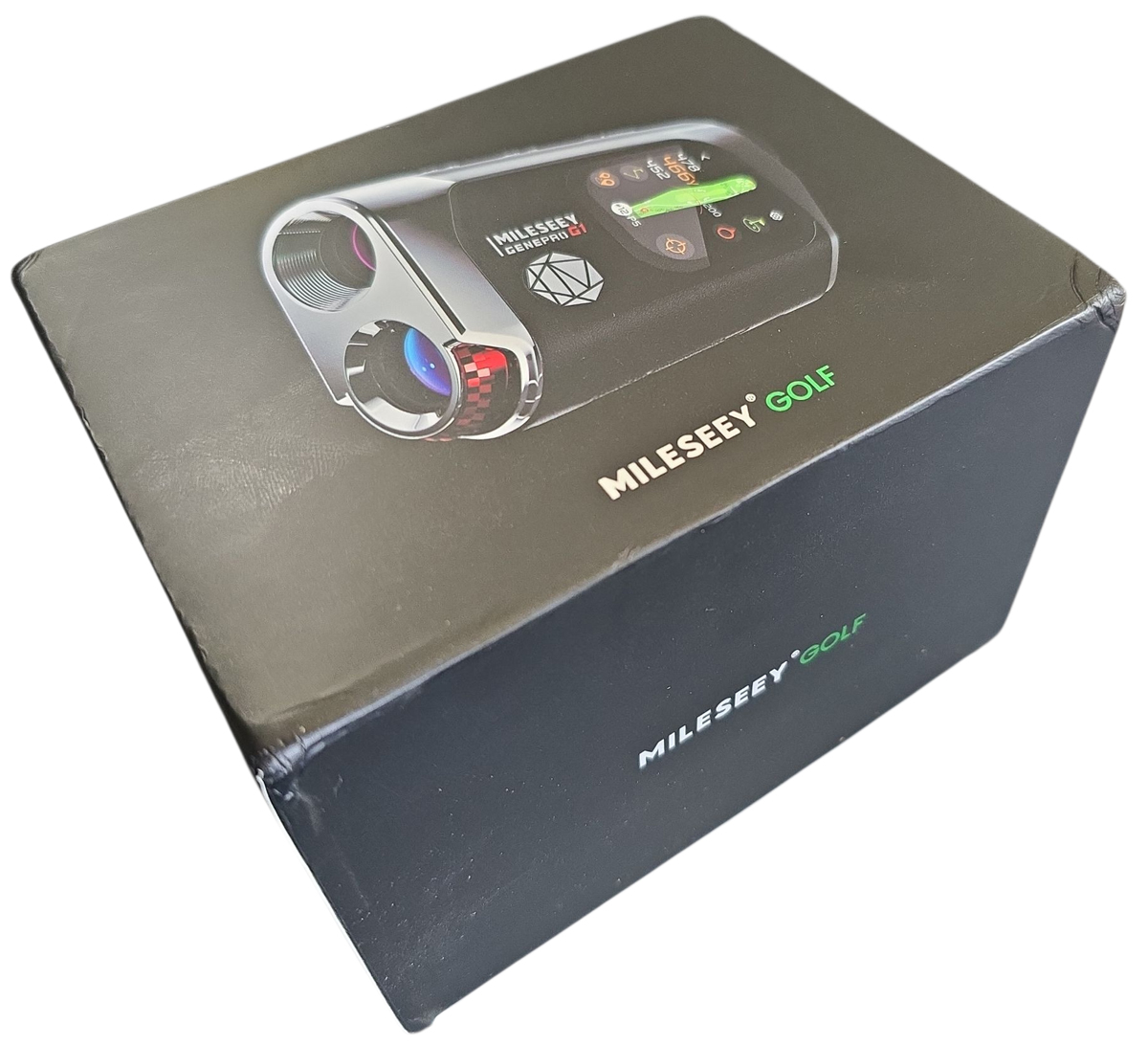
The G1 arrived in a dinged-up box, but that didn’t matter. Everything is well-protected inside the box.
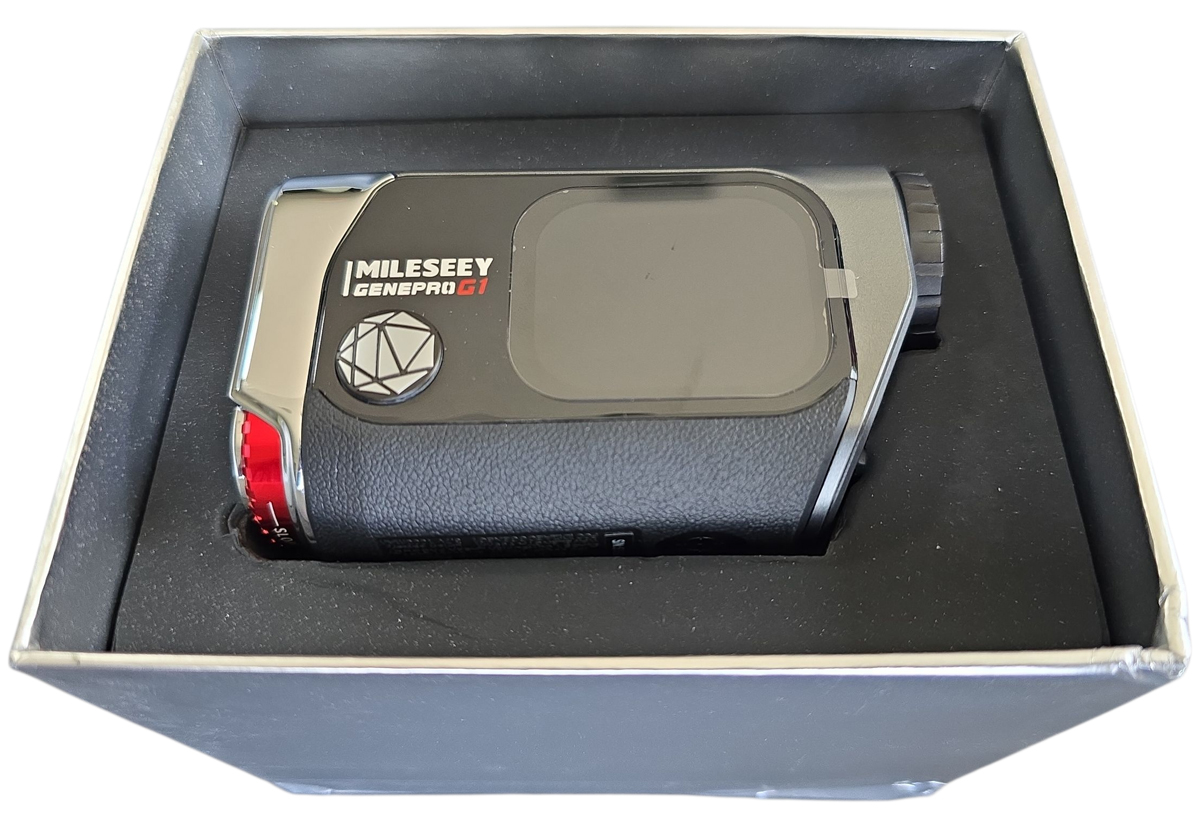
The device itself is shaped pretty much like every other laser rangefinder out there. It has activation buttons along the top and a nice, grippy panel on the side. It is hefty and feels like it is built like a tank. It feels and looks like a quality tool.
You can see the knurled focus adjustment on the left in this image. The rest is covered in classy gray and silver material. The forward 9right in the photo) button lets you enter settings mode with a long press or pin seeker mode with a short press. The middle button turns on ball-to-pin mode, and the back (and larger) button is the measurement button. A short press takes a measurement. Long-pressing lets you scan and take continuous measurements until it locks on a flag.
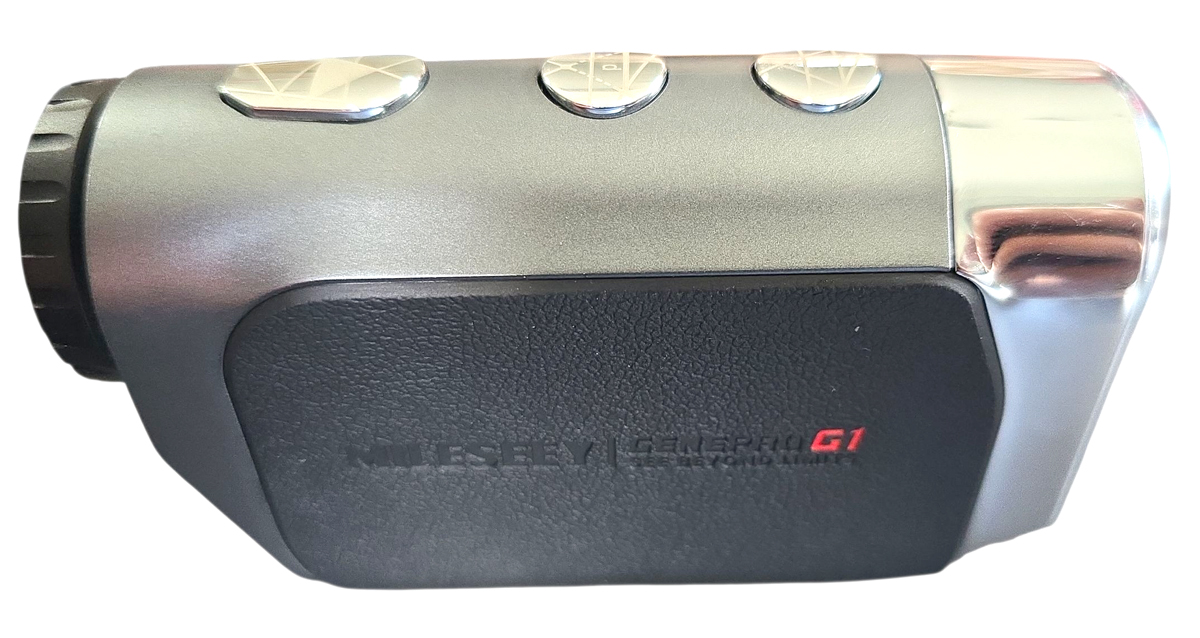
Part of the game-changing design is the bright 2.13″ AMOLED touchscreen display on the opposite side.
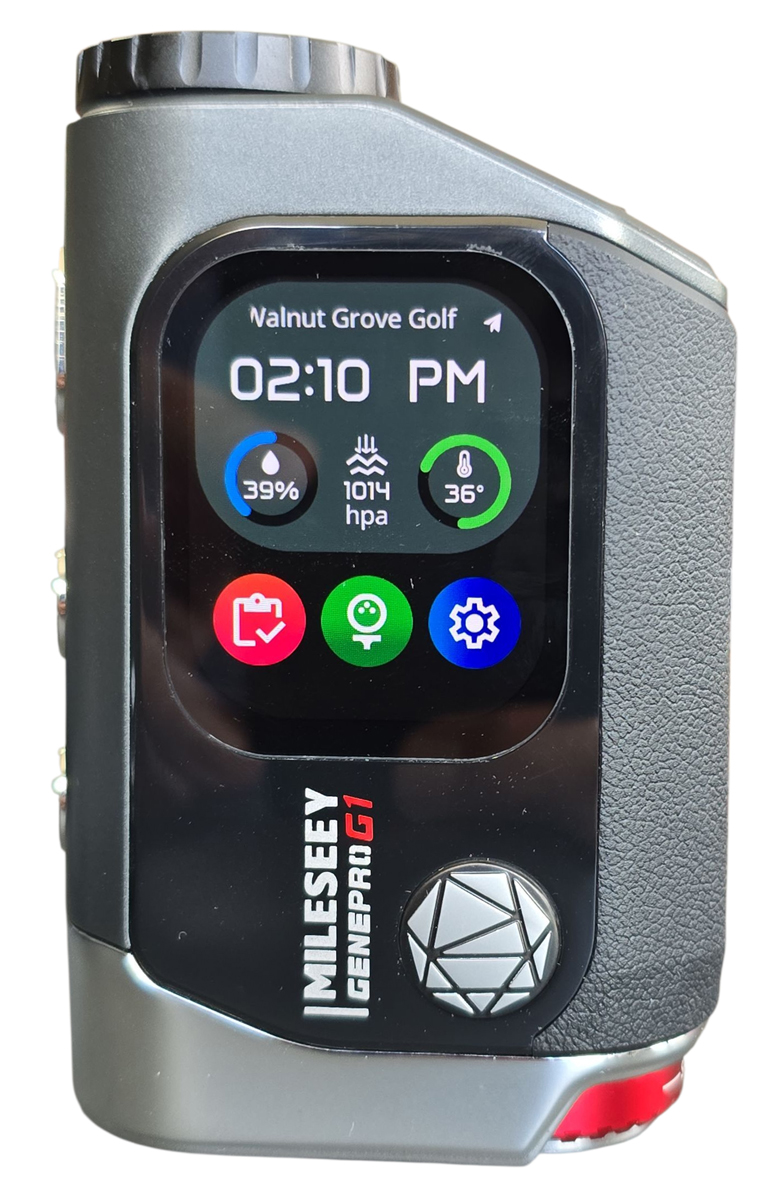
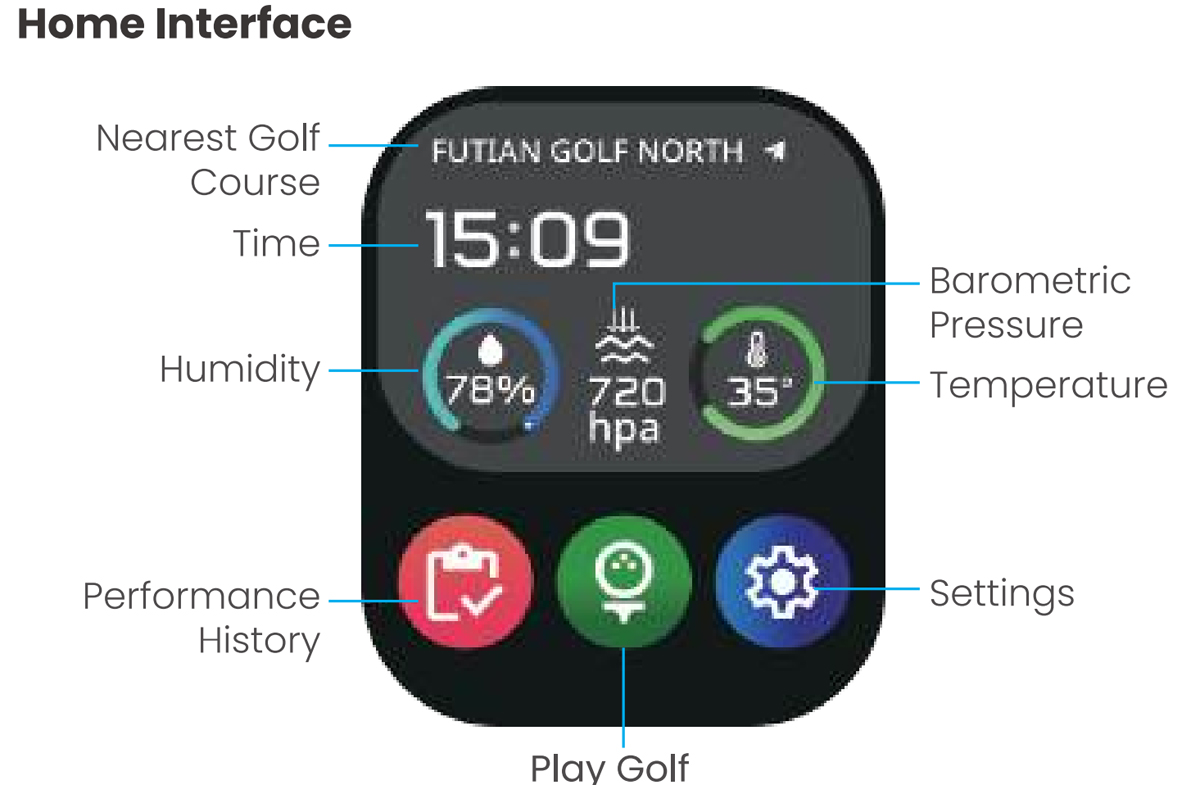
When you’re on the course, the display shows you the hole layout, including all sand and water hazards. You can zoom in for additional details. There are various other mode activation icons that we’ll get into later.
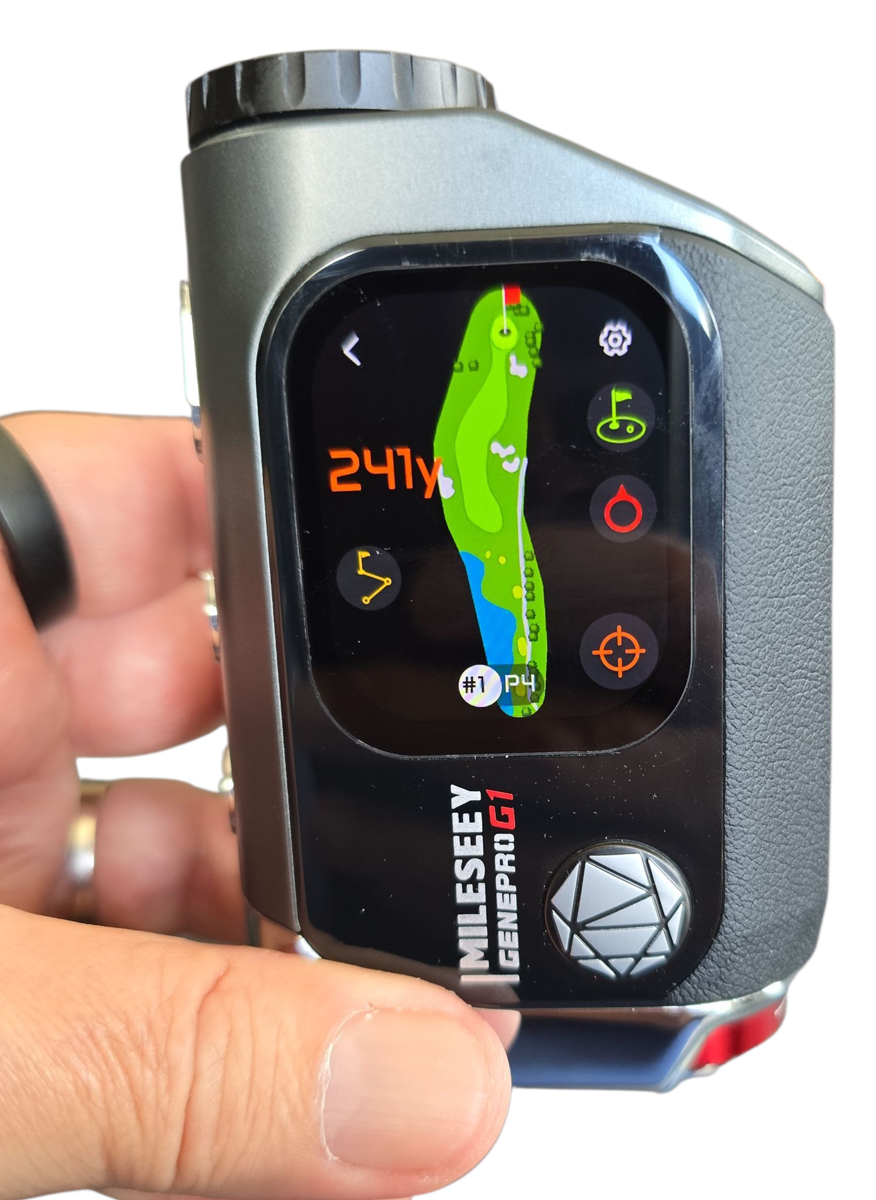
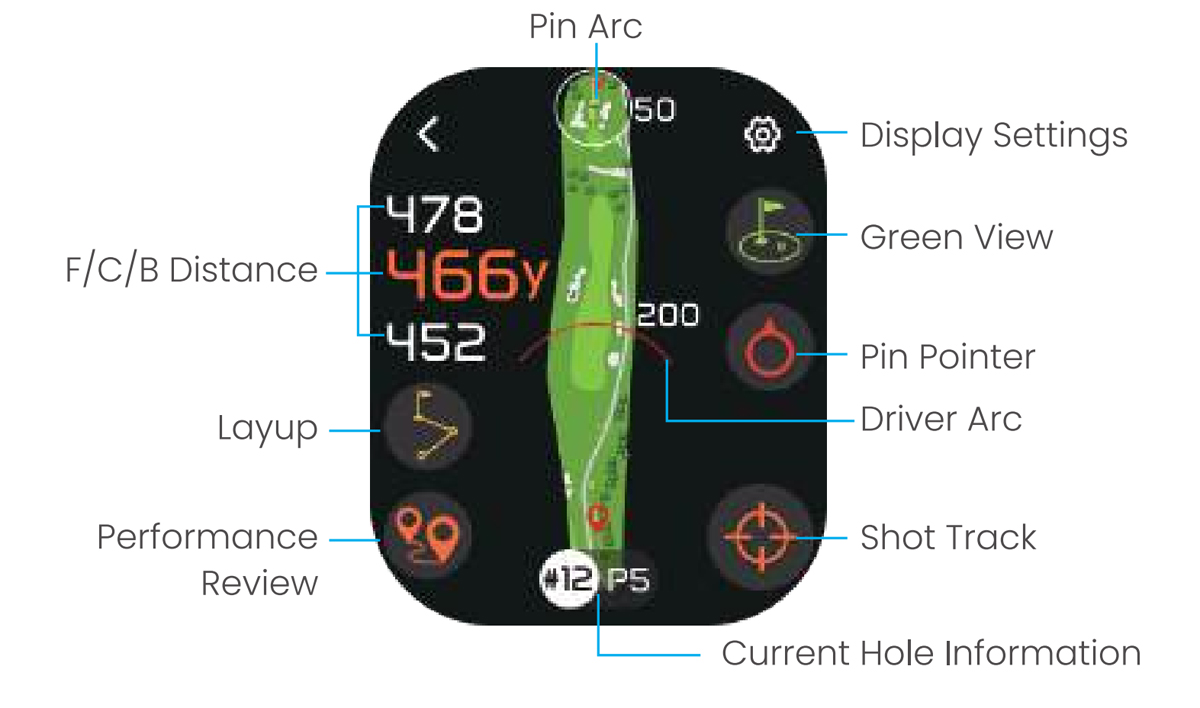
Underneath, we find the GPS activation button and labeling embossed into the unit. You can also see the slope adjustment activation dial. Deactivating slope compensation makes this legal for use in sanctioned tournaments.

The back end has the optic that you put up to your eye. The knurled ring lets you adjust focus. You can also see the cover for the USB-C charging port.
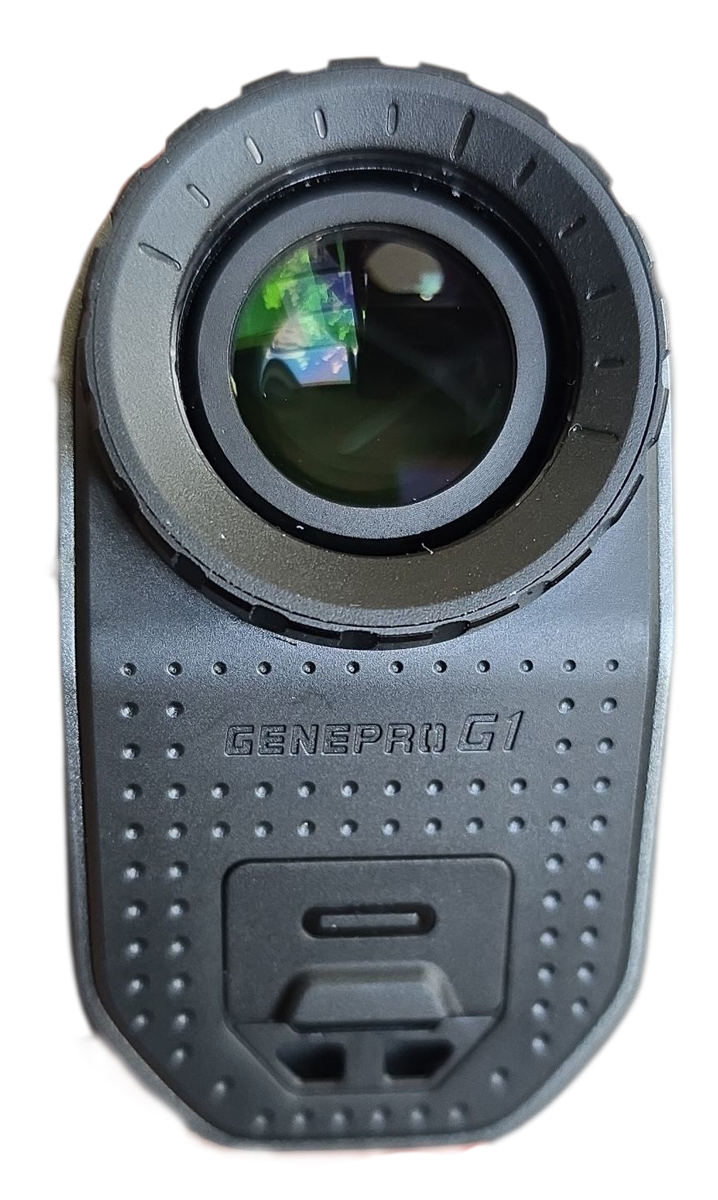
Inside, you’ll see a full-color display. This was the best photo I could get, but trust me, it is crisp and clear when looking through the lens.
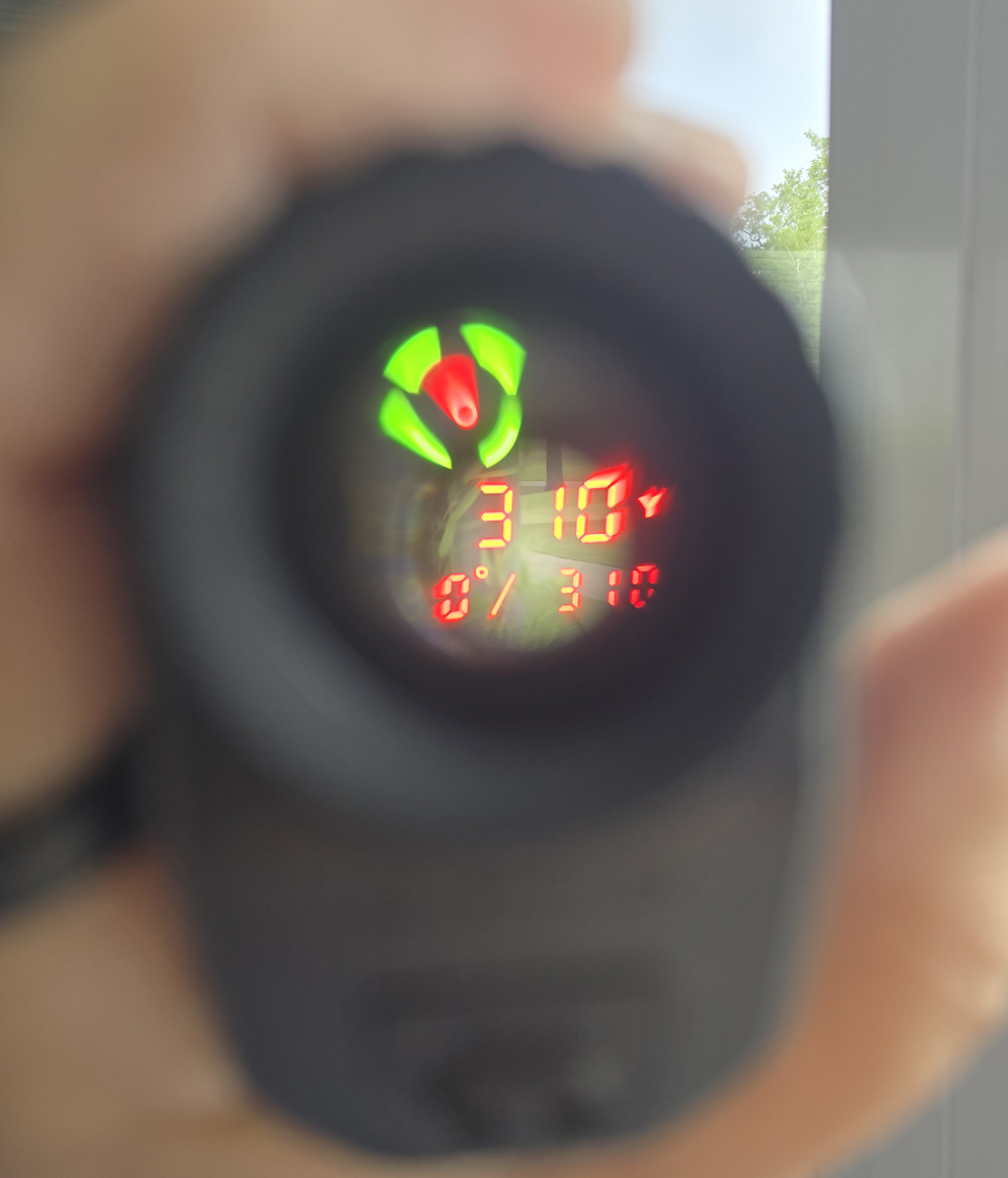
Here’s a better view.
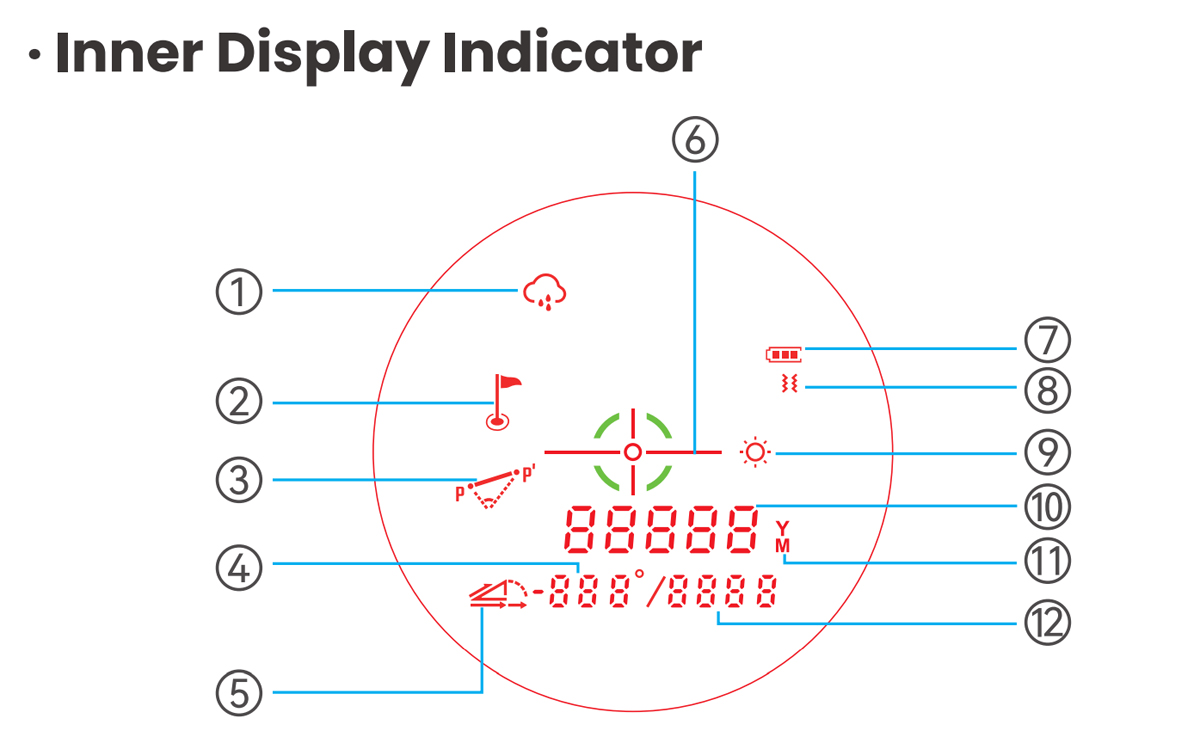
- Rain/fog indicator – this mode can compensate when visibility is low on a foggy/rainy morning
- Flag lock mode
- Ball-to-pin mode
- Slope angle
- Compensation indicator
- Crosshair
- Battery level (although this does not show up on my unit)
- Vibration (this also doesn’t show up on my unit)
- Brightness
- Line of sight distance
- Measurement unit (yards/meters)
- Slope compensated distance
On the front of the unit, we see the optical magnifying lens and the laser emitter and receiver.

Assembly, Installation, Setup
Like most devices these days, you start by fully charging the device via the USB-C charging port on the back of the device.
To fully utilize this device, it needs to be paired with your phone. First, install the Mileseey Golf app and then pair it to your phone using the handy QR code. This will allow you to sync round data to your phone for game analysis and round tracking.

Performance
A GPS golf tool is only as good as the database that supports it. I live on a golf course. The course has three 9-hole courses that make up the 27-hole Lopez Legacy course. The courses are named Ashley Meadows, Erinn Glenn, and Torri Pines. Logically, this was the first course that I chose to explore in the G1’s database. As I looked at the hole layouts, I discovered that they were all wrong. After a little investigation, I figured out that the database had Ashley Meadows incorrectly named Erinn Glenn, and Erinn Glenn incorrectly named Ashley Meadows. The course data was accurate, but the names were not. The fact that the very first course I explored was wrong was a huge red flag for me. With over 43,000 courses in their database, what are the odds that I just happened to find the one error? If you’re heading to the course with a G1, I would absolutely check the database first to be sure it is correct. I’m not sure where Mileseey Golf got their database, because this course has been here for over 20 years and is correct in other golf GPS devices.
The good news is that I reported this discrepancy to Mileseey Golf, and a couple of days later, I received an email asking me to do a quick update to the device via the app. The database was updated, and the course names were correct. At least they were responsive and corrected the issue quickly.
Laser rangefinders are simple. Point, aim, press, get a distance. Simple. GPS rangefinders are easy. Load the course, choose a hole, and read the distance to the center of the green. This device? It can do either of those. Easy. But to get the most out of it, there is a learning curve. This is a complex device. The sheer number of things the G1 can do is almost mindboggling. Laser distance to the pin? Yup. GPS distance to the center of the green? Sure. Stroke distance? Absolutely. Pin finder for blind shots? You got it. Hazard identification? It’s in there. Ball distance to the pin when you’re still on the cart path? That’s available too. Syncing to the app to track shots, scores, and round stats? Oh, yeah. It was time to take the GenePro G1 to the course and see what it can do.
The first course I played was an executive course. That means that most or all of the holes are par 3. In this case, I played Amberwood Golf Course in The Villages, Florida, with eight par 3s and one par 4. This let me work on learning the G1 without needing all the complex functionality.
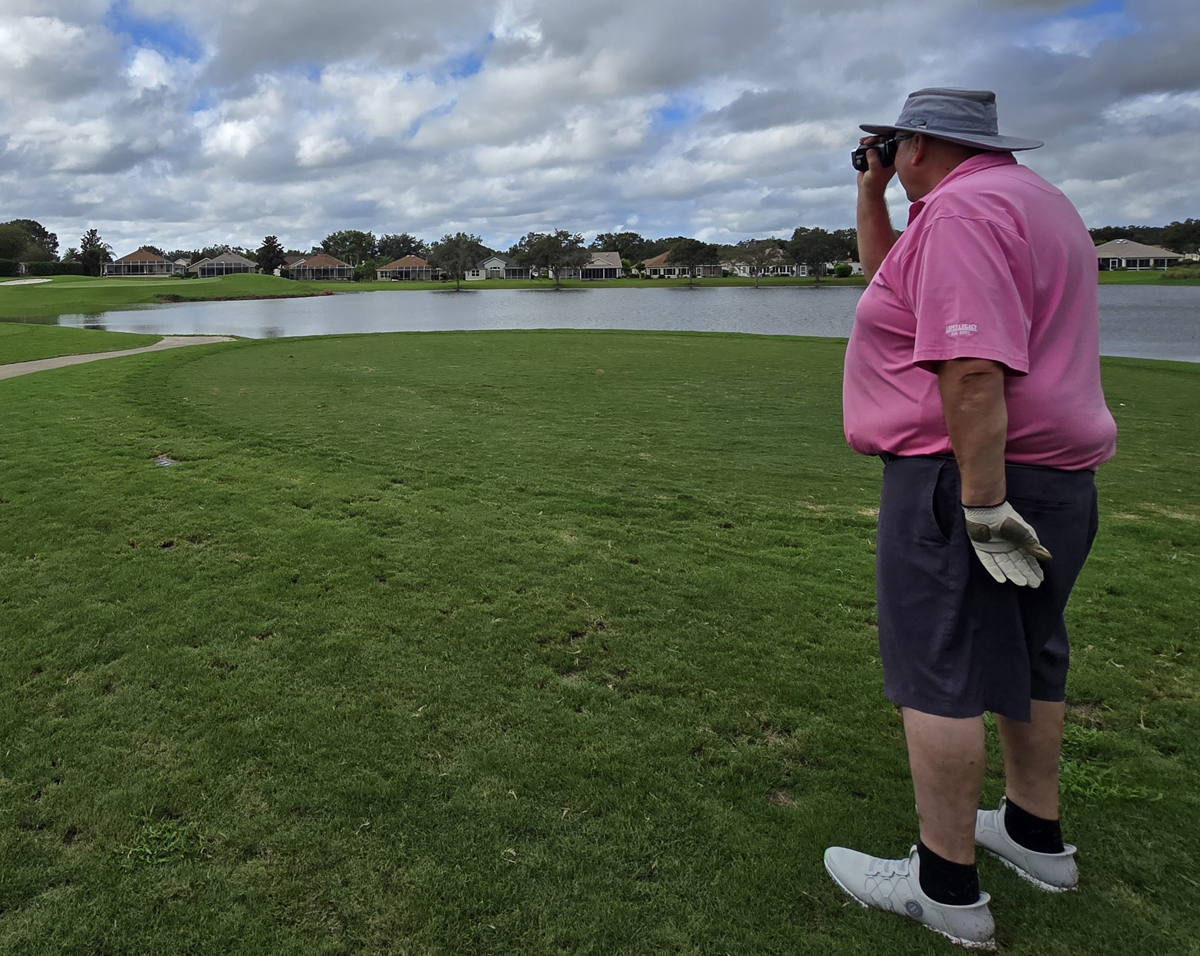
Pin acquisition was lightning-fast with the green circle lighting up and a quick vibration confirmation. Slope compensation seems accurate, suggesting that the hole would play longer or shorter, depending on whether the pit was above or below the tee stand.
Even though the holes were par 3s, I tried the ball-to-pin mode on a hole where the tee stand was a distance from the cart path. I put the G1 into ball-to-pin mode. I targeted the tee marker and then the pin. The G1 showed me the distance to each, then vibrated, and showed me the calculated distance of 108 yards to the pin. I walked up to the tee stand and targeted the pin in pin seeker mode. It came up with 108 yards. Nice! That feature alone could save a bunch of steps on the course. Because the course only had one par 4 hole, using the GPS functionality and shot tracking didn’t really make sense to use.
To use the shot tracking, you need to have the G1 with you so you can make the GPS location of each shot. If you’re in a cart, that’s no problem. But if you have to walk to your ball, that means you have to haul the more than half a pound G1 with you. Nine ounces is a lot to put in your pants or shorts pocket and take a mosey.
Next, I tried it out on a championship course. Here’s a look at the shot planning mode on a short par 4 before teeing off. You can see that the hole is a short 284-yard par 4 with water to the right, trees on the left, and a small sand trap in front of the green. The map accurately showed what I was looking at from the tee.

After an errant tee shot, hitting a tree and landing in the left rough, shot planning shows that a 56-yard chip would land us back in the fairway, leaving 64 yards to the water and 187 to the center of the green.
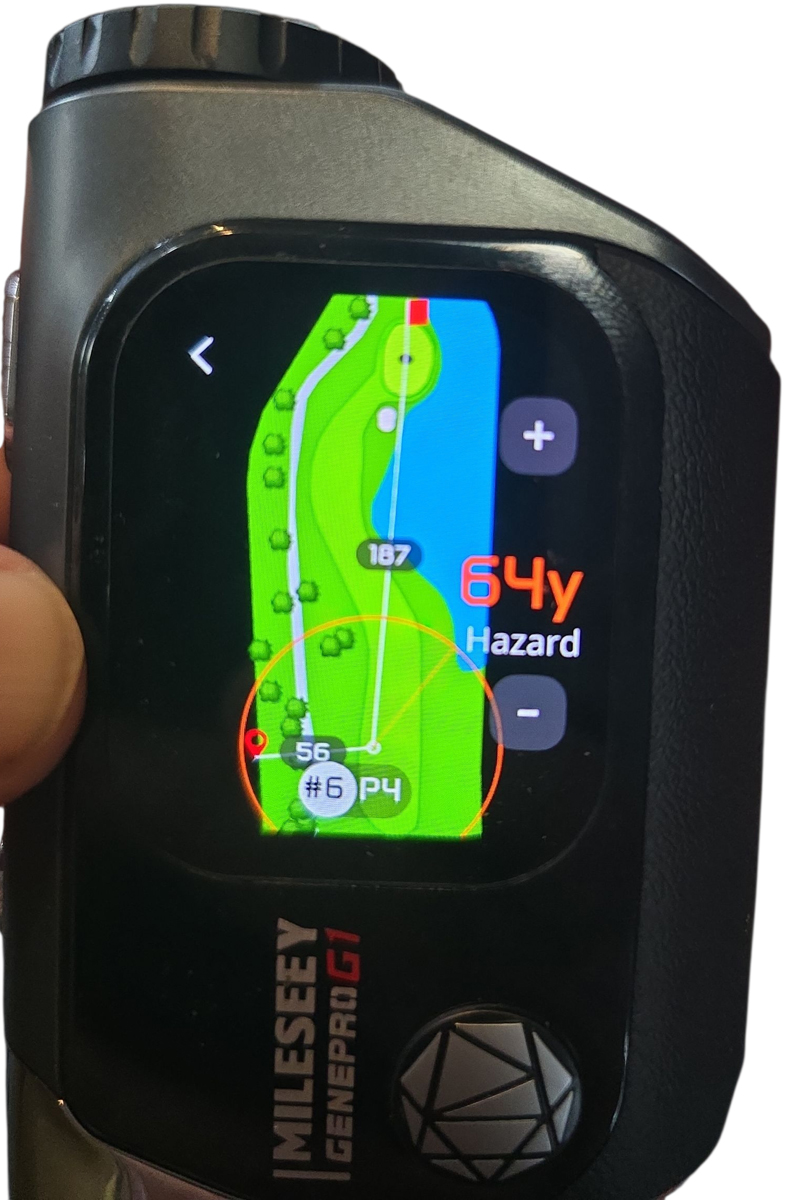
By using the touchscreen, I repositioned my layup shot. I could clearly see that this would need a 126-yard shot to land me ahead in the middle of the fairway, leaving me 45 yards to the sand, and a manageable 79 yards to the center of the green. This was a better plan, assuming that I could clear the tree in front of me. Being able to plan a shot like this is a game-changer. The added benefit of knowing the distance to hazards increases confidence, too.
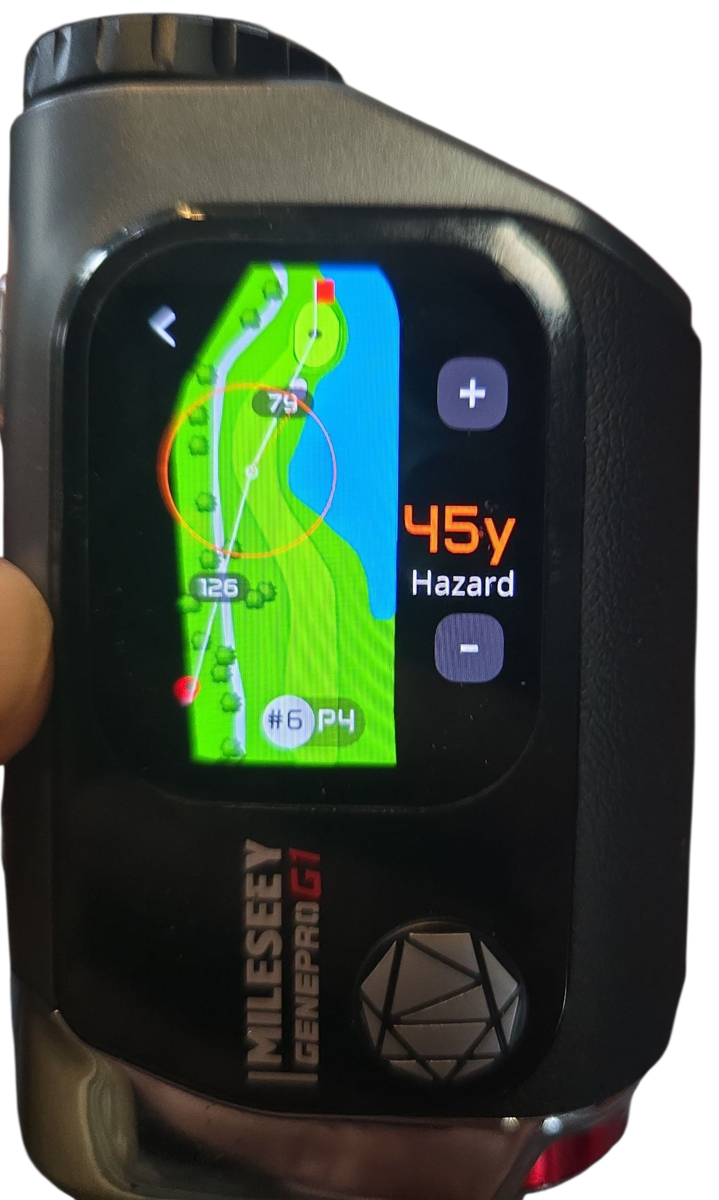
If I had not been able to see the flag, the pin finder showed me the direction to the pin (the arrow is dependent on the position of the G1 and pointed straight to the flag), and that it was 204 yards from where I was standing. This would be invaluable on a blind approach shot.
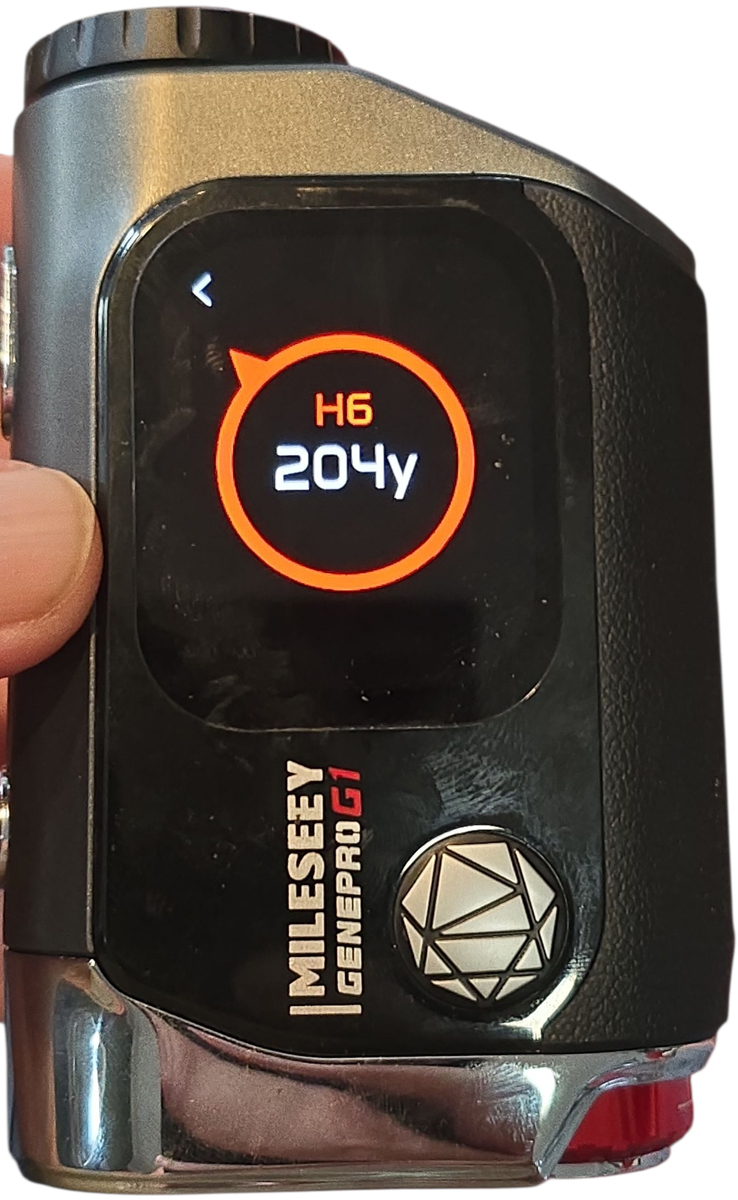
The G1 can also measure all your shot distances. That requires hitting the position button before every shot, and frankly, that will take me several rounds to get in the habit. It can also sync to the Mileseey Golf app on your phone so you can track scores and record stats like greens in regulation, fairways hit, putts, and so on.
As I mentioned in the display description, neither the vibration indicator nor the battery level indicator shows in the display. This means there is no visual indication of how much battery charge is left in the unit. A full charge should last through several rounds, but with the high power demands of both a laser and GPS, I’d recommend charging the G1 every two to three rounds.
Final thoughts
Pro golfers have caddies who give them measurements, shot recommendations, and such. Most of us hack golfers do not use caddies and have to figure this all out on our own. The Milessey Golf GenePro G1 brings a lot of caddie functionality and puts it in the palm of your hand. I was quite impressed with all the features that Mileseey Golf crammed into this amazing little unit.
It wasn’t perfect, though. I can’t turn on the battery life indicator in the settings menu. It shows gray, and no matter how I press it, it won’t turn on. The vibration indicator also doesn’t show up like the manual shows. Those quibbles don’t diminish the awesomeness that is the GenePro G1. If you’re serious about your golf game, this is the rangefinder to get. But, I would caution golfers to verify the G1’s course database before playing, given that the first course I checked was incorrect.
What I like about the Mileseey Golf GenePro G1 Touchscreen & GPS Rangefinder
- Fast pin acquisition
- Accurate distance measurement
- The display is wonderfully bright and visible
- The Ball-to-Pin feature is a huge bonus, especially on days when you’re restricted to the cart path
- The data available by syncing the G1 to the Mileseey Golf app is a huge bonus for golfers who analyze their game
What needs to be improved?
- The golf database seems like it needs a little work, and courses should be verified before playing to avoid surprises
- It is a little heavy to carry in your pocket
- The battery and vibration indicators don’t show up, and I can’t turn the indicators on
- There is so much baked into the G1 that it does have a learning curve to be able to take full advantage of it all
Price: $399 (on sale from $499 as of this writing)
Where to buy: Mileseey Golf; Amazon ($499)
Source: The sample of this product was provided for free by Mileseey Golf. Mileseey Golf did not have a final say on the review and did not preview the review before it was published.
Check out these other golf gadget reviews!
- Vulcao Golf Club/Ball Cleaner Bag and Brush Set review – Cleaning up your golf game
- Scosche BoomBottle MS speaker review – Cupholder tunes for your golf cart


